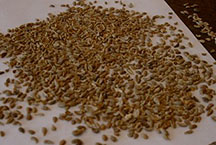Make the most of culinary herbs and spices.
All About Anise
by Sandra Bowens

Next time you are casting about for a dessert to serve after a heavy meal, consider mustaceum. This anise laced cake baked in a wrapping of bay leaves often followed major feasts given by the early Romans. The cake served the dual purposes of a toothsome sweet treat and as an aide in digestion. Mustaceum may well have begun the tradition of wedding cakes as we know it today.
Anise seeds are tiny and crescent shaped with a strong taste of licorice. The plant, Pimpinella anisum, is a slow-growing annual native to Egypt and the Mediterranean. Today it is produced for export in Mexico, Spain, Germany, Turkey and Italy although it is easily cultivated wherever 120 frost-free days can be found. This member of the parsley family should be sown where it is intended to grow as its long taproot does not take well to transplanting.
The frilly, delicate leaves add flavor to salads. Pale yellow flower clusters develop into the fruit that we think of as the seed. The flowers appear about three months after planting. To harvest, the entire umbrella-shaped seed head is snipped off after ripening but before it opens. The seeds are then threshed and dried.
Anise is one of the oldest known seeds. Hippocrates suggested using anise to control coughing and it is referred to in the New Testament. King Edward I allowed it to be used as a way to pay taxes and King Edward IV slept on linen perfumed with anise. Ancient herbals list anise as a good mousetrap bait.
Rodents are not the only animals to find the scent desirable. Anise is the catnip for dogs. Drag hunting foxhounds are encouraged by sacks soaked in anise oil and racing greyhounds are chasing a fake rabbit soaked in the oil. Ground anise is mixed into horse and cattle feed and it is said to make excellent fish bait.
Humans all over the world enjoy the flavor of anise, particularly in liqueurs. Anisette and ouzo are perhaps the most famous but the Latin American aguardiente and the Turkish raki are sure to be familiar too.
The oil of anise used to impart the important licorice flavor in these beverages is frequently used for medicinal purposes. It is common to cough remedies, dental products and helps to mask the bitterness of other medicines.
For culinary purposes, anise seed has wide ranging applications. It is popular in many European confections. The French like it with carrots. Anise is frequently used in Scandinavian breads, East Indian curries, and Hispanic stews. The seed enhances cooked fruit dishes, eggs and cheese, spinach and many baked goods. Cinnamon and bay leaves complement the taste of anise.
Although anise seed is available in whole or ground form, for the best flavor buy whole seeds and crush them just before using. If you don't have a spice grinder this can be accomplished with a mortar and pestle or you might break them with a rolling pin.
Anise seed, or aniseed or anis, has the potential to be confused with other spices and herbs. Star anise is the beautiful fruit of a Chinese bush, Illicium verum. The properties of star anise essential oil are similar to anise seed and it is sometimes used as a commercial substitute. They each make an acceptable substitution for one another in culinary purposes.
Although anise has the taste of licorice and is often used as an artificial flavoring for licorice, true licorice is the hardy perennial Glycyrrihiza glabra. True licorice is preferred over anise in European countries while nearly 90% of that used in the United States goes into tobacco blends.
Anise-hyssop, Agastache foeniculum, is a festive looking plant with spikes of purple flowers. It tastes like a combination of mint and anise but is not related to the anise plant. It's actually a member of the mint family.
Yet another plant mistaken for anise is fennel. Much larger in size, the fennel seed has a flavor that is similar to anise and may be used as a substitute if needed. The leaves from a fresh fennel bulb and the leaves of an anise plant could be interchangeable as well.
Anise-Almond Kisses
1 tube (7 ounces) almond paste
1/2 cup granulated sugar
1/2 teaspoon anise seed, crushed
1 extra-large egg white
Preheat the oven to 325 degrees.
Using your fingertips, knead the sugar into the almond paste. Work in the crushed anise seed and then the egg white.
Place the mixture into a pastry bag fitted with a star tip. Pipe mounds to equal a heaping Tablespoon spaced about an inch apart onto a baking sheet lined with a silicone-coated baking mat. Or simply use two spoons to drop mounds onto a greased baking sheet or parchment paper.
Bake until barely golden brown, about 15 minutes. Allow to cool on the baking sheet before removing.
Makes 2 dozen cookies
Here's one that's full of our favorite recipes because we wrote the book! It is also full of information, helpful hints and ideas for using herbs and spices in your kitchen.
These darlings of the blogosphere take on classic desserts in their own quirky style.
This is no cookbook but a serious look at spice history, cultivation and use.
The latest culinary mystery featuring Goldy as she whips up more tasty treats while chasing criminals in her neighborhood. See aPinchOf.com's review of this book.






